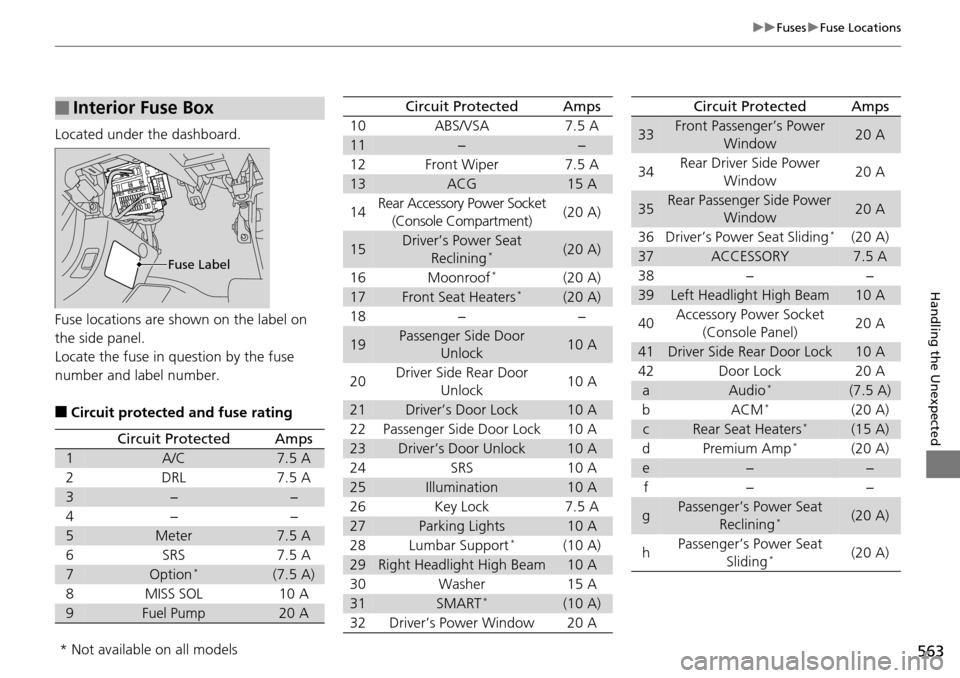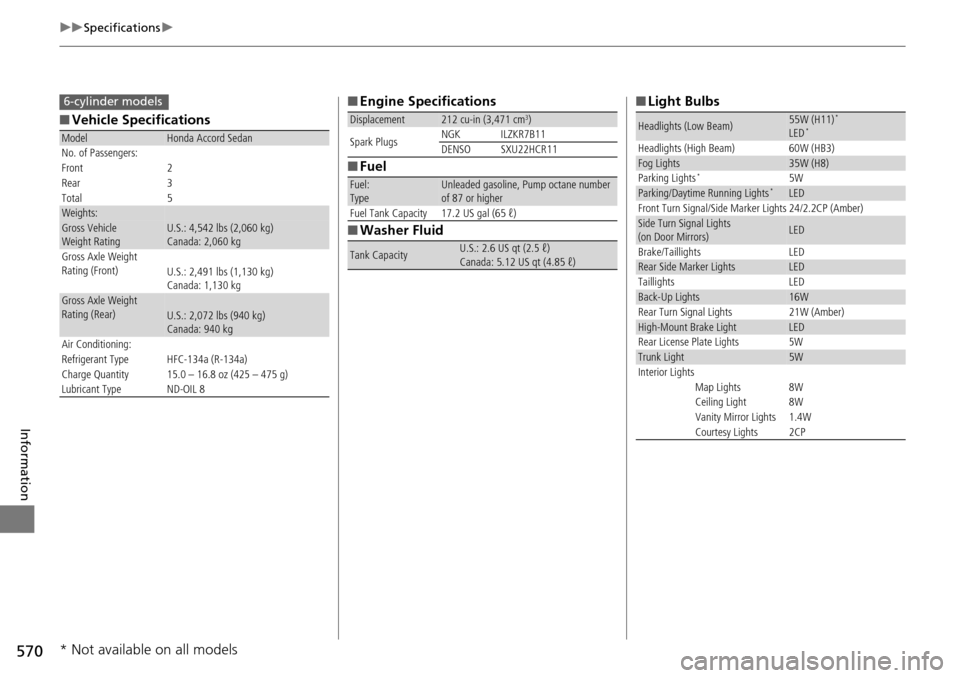Page 559 of 593

558
Handling the Unexpected
Indicator, Coming On/Blinking
If the Low Oil Pressure Indicator Comes On
■Reasons for the indicator to come on
Comes on when the engine oil pressure is low.
■What to do as soon as the indicator comes on
1. Immediately park the vehicle in a safe place.
2. If necessary, turn the ha zard warning lights on.
■What to do after parking the vehicle
1. Stop the engine and let it sit for about one minute.
2. Open the hood and check the oil level.
u Add oil as necessary.
3. Start the engine and check th e low oil pressure indicator.
u The indicator goes off: Start driving again.
u The indicator does not go off within 10 seconds: Stop the engine
and contact a dealer for repairs immediately.
If the Charging System Indicator Comes On
■Reasons for the indicator to come on
Comes on when the battery is not being charged.
■What to do when the indicator comes on
Turn off the heating and cooling system* /climate control system*, rear
defogger, and other electrical systems, and immediately contact a dealer
for repairs.
1 If the Low Oil Pressure Indicator Comes On
NOTICE
Running the engine with low oil pressure can cause
serious mechanical damage almost immediately.
1If the Charging System Indicator Comes On
If you need to stop temporarily, do not turn off the
engine. Restarting the engi ne may rapidly discharge
the battery.
* Not available on all models
Page 561 of 593

560
uuIndicator, Coming On/Blinking uIf the Brake System Indicator (Red) Comes On
Handling the Unexpected
If the Brake System Indicator (Red) Comes On
■Reasons for the indicator to come on
• The brake fluid is low.
• There is a malfunction in the brake system.
■What to do when the indicator comes on while driving
Press the brake pedal lightly to check pedal pressure.
• If normal, check the brake fluid level the next time you stop.
• If abnormal, take immediate action. If necessary, downshift the
transmission to slow the vehicle using engine braking.
If the Electric Power Steeri ng (EPS) System Indicator
Comes On
■Reasons for the indicator to come on
• Comes on when there is a problem with the EPS system.
• If you depress the accelerator pedal repeatedly to increase the engine
speed while the engine is idling, the indicator comes on, and
sometimes the steering wheel becomes harder to operate.
■What to do when the indicator comes on
Stop the vehicle in a safe place and restart the engine.
If the indicator comes on and stays on, immediately have your vehicle
inspected by a dealer.
1 If the Brake System Indicator (Red) Comes On
Have your vehicle re paired immediately.
It is dangerous to drive with low brake fluid. If there
is no resistance from the brake pedal, stop
immediately in a safe plac e. If necessary downshift
the gears.
If the brake system indicator and ABS indicator come
on simultaneously, the elec tronic brake distribution
system is not working. Th is can result in vehicle
instability under sudden braking.
Have your vehicle inspecte d by a dealer immediately.U.S.
Canada
Page 563 of 593

562
Handling the Unexpected
Fuses
Fuse Locations
If any electrical devices are not working,
turn the ignition switch to LOCK
(0*1 and
check to see if any appl icable fuse is blown.
Located near the brake fluid reservoir. Push
the tabs to open the box.
Fuse locations are shown on the fuse box
cover. Locate the fuse in question by the
fuse number and box cover number.
■Circuit protected and fuse rating
■Engine Compartment Fuse Box
Circuit ProtectedAmps
1Battery125 A
2
EPS70 A
Fuse Box Main 1 (60 A)
Fuse Box Option 1(40 A)
−−
−−
ABS/VSA FSR 40 A
ABS/VSA Motor 30 A
3
−−
−−
−−
−−
4 Front Fog Light*(15 A)
5Horn10 A
6 Stop Light 10 A
7FI Sub15 A
8 DRL (7.5 A)
9IG Coil15 A
10 Injector*220 A
11Hazard15 A
12 Fuse Box Main 2 60 A
Fuse Box Option 2 (40 A)
IG Main 1 50 A
30 A
*4
IG Main 2*430 A
Sub Fan Motor 20 A*2
30 A*3
Headlight Low Beam Main 30 A
Fuse Box 30 A
Wiper Motor 30 A
Main Fan Motor 30 A Starter Motor
*430 A
13Rear Defogger40 A
14 Heater Motor 40 A
15FI Main15 A
Circuit ProtectedAmps
*1:Models with the smart entry system have an
ENGINE START/STOP button instead of an
ignition switch.
*2:4-cylinder models
*3:6-cylinder models
*4:Models with smart entry system 16 Heated Door Mirror
*(10 A)
17MG Clutch7.5 A
18 DBW 15 A
19Small Light20 A
20 Interior Light 7.5 A
21Back Up10 A
22 Audio 10 A
23Fan Timer7.5 A
24 Right Headlight Low Beam 10 A
25Left Headlight Low Beam10 A
26 − −
Circuit ProtectedAmps
* Not available on all models
Page 564 of 593

563
uuFuses uFuse Locations
Handling the Unexpected
Located under the dashboard.
Fuse locations are shown on the label on
the side panel.
Locate the fuse in question by the fuse
number and label number.
■Circuit protected and fuse rating
■Interior Fuse Box
Fuse Label
Circuit ProtectedAmps
1A/C7.5 A
2DRL7.5 A
3−−
4−−
5Meter7.5 A
6SRS7.5 A
7Option*(7.5 A)
8MISS SOL10 A
9Fuel Pump20 A
10ABS/VSA7.5 A
11−−
12Front Wiper7.5 A
13ACG15 A
14Rear Accessory Power Socket
(Console Compartment)(20 A)
15Driver’s Power Seat Reclining*(20 A)
16Moonroof*(20 A)
17Front Seat Heaters*(20 A)
18−−
19Passenger Side Door Unlock10 A
20Driver Side Rear Door
Unlock10 A
21Driver’s Door Lock10 A
22Passenger Side Door Lock10 A
23Driver’s Door Unlock10 A
24SRS10 A
25Illumination10 A
26Key Lock7.5 A
27Parking Lights10 A
28Lumbar Support*(10 A)
29Right Headlight High Beam10 A
30Washer15 A
31SMART*(10 A)
32Driver’s Power Window20 A
Circuit ProtectedAmps
33Front Passenger’s Power Window20 A
34Rear Driver Side Power Window20 A
35Rear Passenger Side Power Window20 A
36Driver’s Power Seat Sliding*(20 A)
37ACCESSORY7.5 A
38−−
39Left Headlight High Beam10 A
40Accessory Power Socket
(Console Panel)20 A
41Driver Side Rear Door Lock10 A
42Door Lock20 A
aAudio*(7.5 A)
bACM*(20 A)
cRear Seat Heaters*(15 A)
dPremium Amp*(20 A)
e−−
f−−
gPassenger’s Power Seat Reclining*(20 A)
hPassenger’s Power Seat Sliding*(20 A)
Circuit ProtectedAmps
* Not available on all models
Page 565 of 593

564
uuFuses uInspecting and Changing Fuses
Handling the Unexpected
Inspecting and Changing Fuses
1. Turn the ignition switch to LOCK (0*1. Turn
headlights and all accessories off.
2. Remove the fuse box cover.
3. Check the large fuse in the engine
compartment.
u If the fuse is blown, use a Phillips-head
screwdriver to remo ve the screw and
replace it with a new one.
4. Inspect the small fuses in the engine
compartment and the vehicle interior.
u If there is a burned out fuse, remove it
with the fuse puller and replace it with a
new one.
*1: Models with the smar t entry system have an ENGINE START/STOP button instead of
an ignition switch.
1 Inspecting and Changing Fuses
NOTICE
Replacing a fuse with on e that has a higher rating
greatly increases the chances of damaging the
electrical system.
Replace fuse with a spare fuse of the same specified
amperage.
Confirm the specified amperage using the charts on
P. 562 to 563.
There is a fuse puller on the back of the engine
compartment fuse box cover.
Combined
Fuse Blown Fuse
Fuse Puller
Page 569 of 593

568
Information
Specifications
■Vehicle Specifications
*1: LX models
*2: Except LX models
ModelHonda Accord Sedan
No. of Passengers:
Front 2
Rear 3
Total 5
Weights:Gross Vehicle
Weight Rating U.S.: 4,200 lbs (1,905 kg)*1
4,321 lbs (1,960 kg)*2
Canada: 1,930 kg*1
1,980 kg*2
Gross Axle Weight
Rating (Front)U.S.: 2,249 lbs (1,020 kg)*1
2,315 lbs (1,050 kg)*2
Canada: 1,030 kg*1
1,065 kg*2
Gross Axle Weight
Rating (Rear)U.S.: 2,006 lbs (910 kg)*1
2,050 lbs (930 kg)*2
Canada: 910 kg*1
930 kg*2
Air Conditioning:
Refrigerant Type HFC-134a (R-134a)
Charge Quantity 15.0 – 16.8 oz (425 – 475 g)
Lubricant Type ND-OIL 8
4-cylinder models■ Engine Specifications
■ Fuel
■ Washer Fluid
Displacement144 cu-in (2,356 cm3)
Spark Plugs NGK DILKAR7G11GS
DENSO DXE22HQR-D11S
Fuel:
TypeUnleaded gasoline, Pump octane number
of 87 or higher
Fuel Tank Capacity 17.2 US gal (65 ℓ)
Tank CapacityU.S.: 2.6 US qt (2.5 ℓ)
Canada: 5.12 US qt (4.85 ℓ)
■ Light Bulbs
Headlights (Low Beam)55W (H11)*
LED*
Headlights (High Beam) 60W (HB3)Fog Lights*35W (H8)
Parking Lights*5WParking/Daytime Running Lights*LED
Front Turn Signal/Side Marker Lights 24/2.2CP (Amber)
Side Turn Signal Lights
(on Door Mirrors)*LED
Brake/Taillights/Rear Side Marker
Lights
*21/5W
Brake/Taillights*LED
Rear Side Marker Lights*LED
Taillights3CP*
LED*
Back-Up Lights 16WRear Turn Signal Lights21W (Amber)
High-Mount Brake Light LED
Rear License Plate Lights5W
Trunk Light 5W
Interior LightsMap Lights8WCeiling Light8WVanity Mirror Lights*1.4WCourtesy Lights*2CP
* Not available on all models
Page 571 of 593

570
uuSpecifications u
Information
■Vehicle Specifications
ModelHonda Accord Sedan
No. of Passengers:
Front 2
Rear 3
Total 5
Weights:Gross Vehicle
Weight Rating U.S.: 4,542 lbs (2,060 kg)
Canada: 2,060 kg
Gross Axle Weight
Rating (Front)U.S.: 2,491 lbs (1,130 kg)
Canada: 1,130 kg
Gross Axle Weight
Rating (Rear)U.S.: 2,072 lbs (940 kg)
Canada: 940 kg
Air Conditioning:
Refrigerant Type HFC-134a (R-134a)
Charge Quantity 15.0 – 16.8 oz (425 – 475 g)
Lubricant Type ND-OIL 8
6-cylinder models■ Engine Specifications
■ Fuel
■ Washer Fluid
Displacement212 cu-in (3,471 cm3)
Spark Plugs NGK ILZKR7B11
DENSO SXU22HCR11
Fuel:
TypeUnleaded gasoline, Pump octane number
of 87 or higher
Fuel Tank Capacity 17.2 US gal (65 ℓ)
Tank CapacityU.S.: 2.6 US qt (2.5 ℓ)
Canada: 5.12 US qt (4.85 ℓ)
■ Light Bulbs
Headlights (Low Beam)55W (H11)*
LED*
Headlights (High Beam) 60W (HB3)Fog Lights35W (H8)
Parking Lights*5WParking/Daytime Running Lights*LED
Front Turn Signal/Side Marker Lights 24/2.2CP (Amber)
Side Turn Signal Lights
(on Door Mirrors)LED
Brake/Taillights LED
Rear Side Marker LightsLED
Taillights LED
Back-Up Lights16W
Rear Turn Signal Lights 21W (Amber)
High-Mount Brake LightLED
Rear License Plate Lights 5W
Trunk Light5WInterior LightsMap Lights8WCeiling Light8WVanity Mirror Lights1.4WCourtesy Lights2CP
* Not available on all models
Page 577 of 593
576
uuEmissions Testing uTesting of Readiness Codes
Information
7. Select a nearby, lightly traveled major hi ghway where you can maintain a speed
of 50 to 60 mph (80 to 97 km/h) for at least 20 minutes. Drive on the highway in
(D (automatic/CVT) or 5th (manual). Do not use cruise control. When traffic
allows, drive for 90 seconds without moving the accelerator pedal. (Vehicle speed
may vary slightly; this is okay.) If you cannot do this for a continuous 90 seconds
because of traffic conditions, drive for at least 30 seconds, then repeat it two
more times (for a total of 90 seconds).
8. Drive in city/suburban traffic for at least 10 minutes. When traffic conditions
allow, let the vehicle coast for several se conds without using the accelerator pedal
or the brake pedal.
9. Park the vehicle and leave the engine off for 30 minutes.